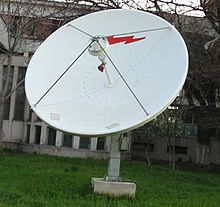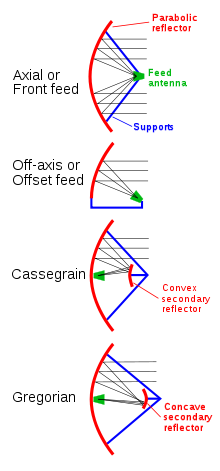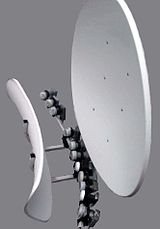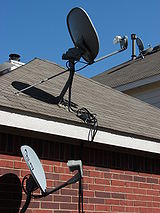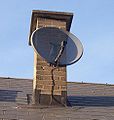- Satellite dish
-
A satellite dish is a dish-shaped type of parabolic antenna designed to receive microwaves from communications satellites, which transmit data transmissions or broadcasts, such as satellite television.
Contents
Principle of operation
The parabolic shape of a dish reflects the signal to the dish’s focal point. Mounted on brackets at the dish's focal point is a device called a feedhorn. This feedhorn is essentially the front-end of a waveguide that gathers the signals at or near the focal point and 'conducts' them to a low-noise block downconverter or LNB. The LNB converts the signals from electromagnetic or radio waves to electrical signals and shifts the signals from the downlinked C-band and/or Ku-band to the L-band range. Direct broadcast satellite dishes use an LNBF, which integrates the feedhorn with the LNB. (A new form of omnidirectional satellite antenna, which does not use a directed parabolic dish and can be used on a mobile platform such as a vehicle was announced by the University of Waterloo in 2004.[1]
The theoretical gain (directive gain) of a dish increases as the frequency increases. The actual gain depends on many factors including surface finish, accuracy of shape, feedhorn matching. A typical value for a consumer type 60 cm satellite dish at 11.75 GHz is 37.50 dB.
With lower frequencies, C-band for example, dish designers have a wider choice of materials. The large size of dish required for lower frequencies led to the dishes being constructed from metal mesh on a metal framework. At higher frequencies, mesh type designs are rarer though some designs have used a solid dish with perforations.
A common misconception is that the LNBF (low-noise block/feedhorn), the device at the front of the dish, receives the signal directly from the atmosphere. For instance, one BBC News downlink shows a "red signal" being received by the LNBF directly instead of being beamed to the dish, which because of its parabolic shape will collect the signal into a smaller area and deliver it to the LNBF.[2]
Modern dishes intended for home television use are generally 43 cm (18 in) to 80 cm (31 in) in diameter, and are fixed in one position, for Ku-band reception from one orbital position. Prior to the existence of direct broadcast satellite services, home users would generally have a motorised C-band dish of up to 3 metres in diameter for reception of channels from different satellites. Overly small dishes can still cause problems, however, including rain fade and interference from adjacent satellites.
Europe
In Europe the frequencies used by DBS services are 10.7–12.75 GHz on two polarisations H (Horizontal) and V (Vertical). This range is divided into a "low band" with 10.7–11.7 GHz, and a "high band" with 11.7–12.75 GHz. This results in two frequency bands, each with a bandwidth of about 1 GHz, each with two possible polarizations. In the LNB they become down converted to 950–2150 MHz, which is the frequency range allocated for the satellite service on the coaxial cable between LNBF and receiver. Lower frequencies are allocated to cable and terrestrial TV, FM radio, etc. Only one of these frequency bands fits on the coaxial cable, so each of these bands needs a separate cable from the LNBF to a switching matrix or the receiver needs to select one of the 4 possibilities at a time.[citation needed]
Systems design
In a single receiver residential installation there is a single cable from receiver to LNB and the receiver uses different power supply voltages (13/18V) to select polarization and pilot tones (22 kHz) to instruct the LNB to select one of the two frequency bands. In larger installations each band and polarization is given its own cable, so there are 4 cables from the LNB to a switching matrix, which allows the connection of multiple receivers in a star topology using the same signalling method as in a single receiver installation.[citation needed]
Types
Motor-driven dish
A dish that is mounted on a pole and driven by a stepper motor or a servo can be controlled and rotated to face any satellite position in the sky. Motor-driven dishes are popular with enthusiasts. There are three competing standards: DiSEqC, USALS, and 36v positioners. Many receivers support all of these standards.
Multi-satellite
Some designs enable simultaneous reception from multiple different satellite positions without re-positioning the dish. The vertical axis operates as an off-axis concave parabolic concave hyperbolic Cassegrain reflector, while the horizontal axis operates as a concave convex Cassegrain. The spot from the main dish wanders across the secondary, which corrects astigmatism by its varying curvature. The elliptic aperture of the primary is designed to fit the deformed illumination by the horns. Due to double spill-over, this makes more sense for a large dish.
VSAT
A common type of dish is the very small aperture terminal (VSAT). This provides two way satellite internet communications for both consumers and private networks for organisations. Today most VSATs operate in Ku band; C band is restricted to less populated regions of the world. There is a move which started in 2005 towards new Ka band satellites operating at higher frequencies, offering greater performance at lower cost. These antennas vary from 74 to 120 cm (29 to 47 in) in most applications though C-band VSATs may be as large as 4 m (13 ft).
Others
- Individual dishes serving one dwelling: Direct to Home (DTH).
- Collective dishes, shared by several dwellings: satellite master antenna television (SMATV) or communal antenna broadcast distribution (CABD).
- Automatic Tracking Satellite Dish
- Big ugly dish
Ad hoc
The dish is a reflector antenna and almost anything that reflects radio frequencies can be used as a reflector antenna. This has led to dustbin lids, woks and other items being used as "dishes". Coupled with low noise LNBs and the higher transmission power of DTH satellites, it is easier to get a usable signal on some of these "dishes".
See also
References
- ^ "Team develops in-car satellite TV". University of Waterloo. 2006-05-06. http://newsrelease.uwaterloo.ca/news.php?id=4072. Retrieved 2008-04-29.
- ^ "News 24 STILL gets an F for physics". http://bnb.bpweb.net/N24/news24.htm. Retrieved 2008-04-29.
External links
- European Commission: The right to use a satellite dish.
- DishPointer – Satellite dish alignment with Google Maps.
- Guide explaining how to align a satellite dish.
- Online Satellite Finder Based on Google Maps
-
General Electric satellite dish for Directv® Satellite Television, Pointing at 101 degrees west.
Satellite communication Main articles Hardware Satellite radio/TV Broadcast radio/tv companies Astra Digital Radio · 1worldspace · Sirius Satellite Radio · Sirius XM Radio · XM Satellite Radio · Dish Network · DirecTV · AfriStar · Sky Television plcRelay satellite companies Inmarsat · SES Astra · Eutelsat · Echostar · Hughes Network Systems · SED Systems · Tooway · Viasat · Globalstar · TelesatSatellite Manufacturing companies Trade organizations See also: Category:Communications satellitesCategories:- Consumer electronics
- Broadband
- Radio frequency antenna types
- Satellite television
Wikimedia Foundation. 2010.

